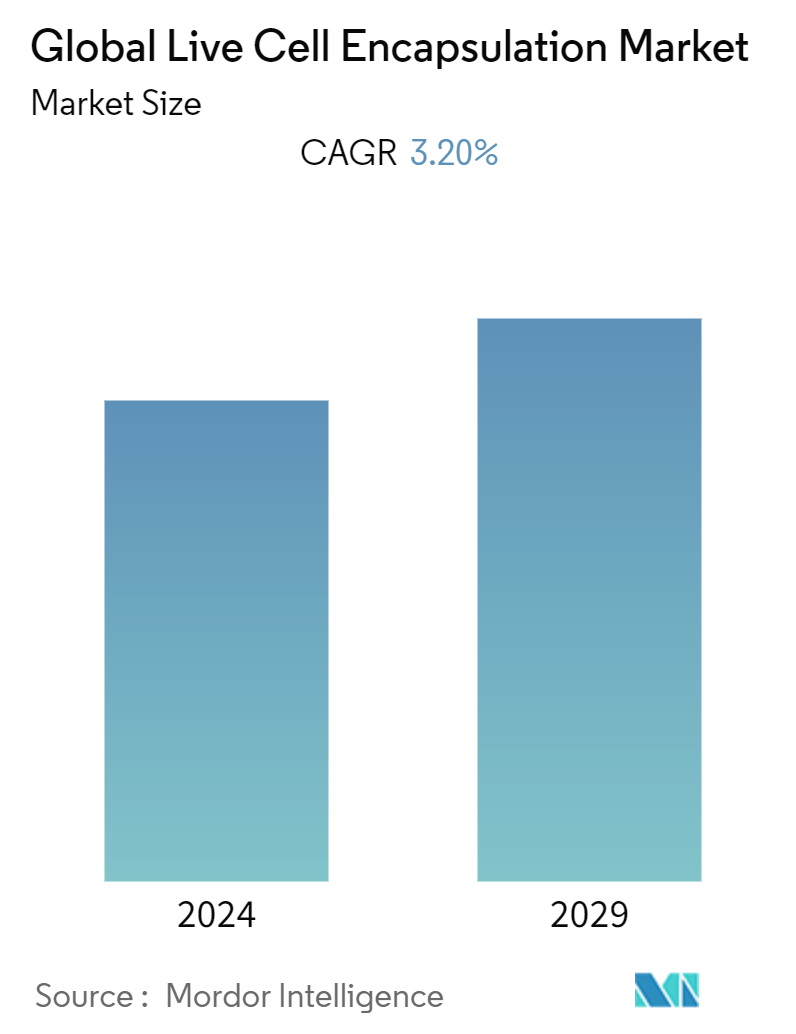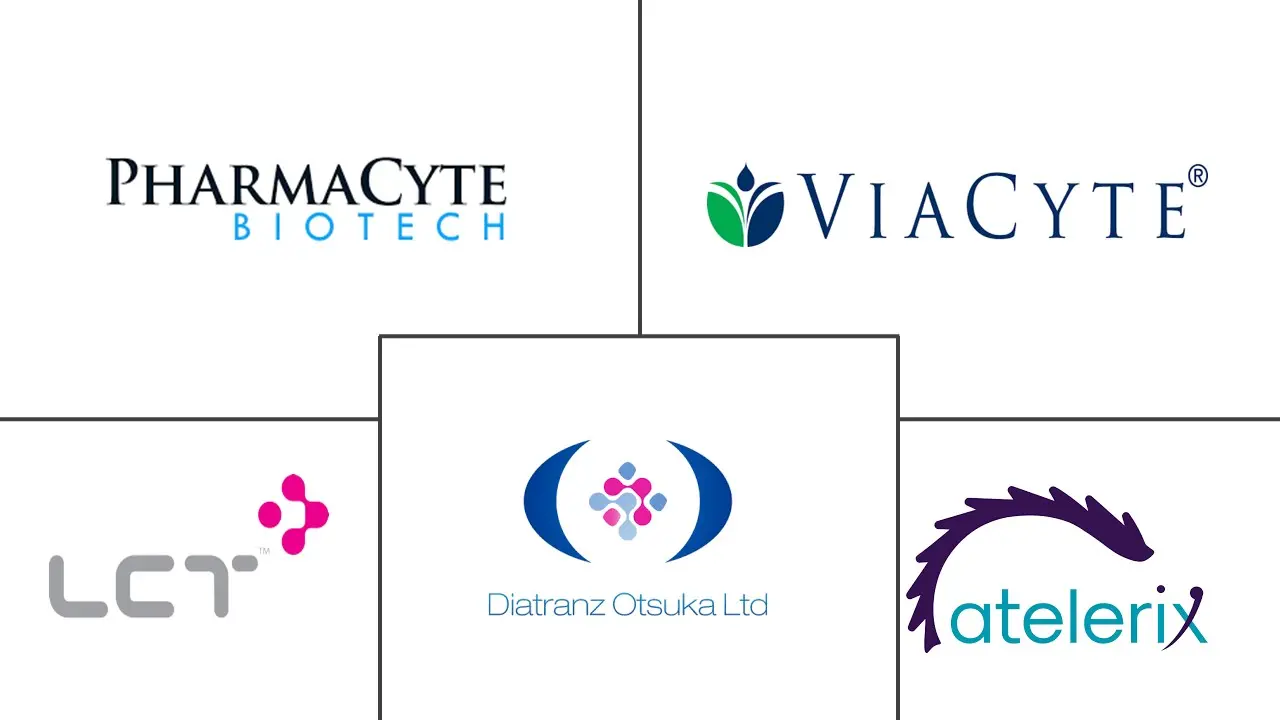Market Size of Global Live Cell Encapsulation Industry

| Study Period | 2019 - 2029 |
| Base Year For Estimation | 2023 |
| Forecast Data Period | 2024 - 2029 |
| CAGR (2024 - 2029) | 3.20 % |
| Fastest Growing Market | Asia Pacific |
| Largest Market | North America |
Major Players
*Disclaimer: Major Players sorted in no particular order |
Global Live Cell Encapsulation Market Analysis
The Global Live Cell Encapsulation Market is expected to register a CAGR of 3.20% during the forecast period.
The Live-cell encapsulation market was significantly impacted by COVID-19. However, various COVID-19 vaccines are RNA encapsulated, impacting market growth over the pandemic period. For instance, according to the study published in the Journal of Virus Research in October 2021, 1273 mRNA is a vaccine made up of synthetic mRNA encapsulated in lipid nanoparticles (LNPs) that codes for SARS-full-length, CoV-2's pre-fusion stabilized spike protein. Additionally, in May 2021, Moderna and the Vaccine Research Centre worked on an mRNA-based vaccine candidate encapsulating the mRNA in lipid nanoparticles, while Codagenix worked on a live attenuated viral vaccine in collaboration with the Serum Institute of India. Thus, the use of live cell encapsulation procedures in the development of COVID-19 treatment therapies during the pandemic had a notable impact on the market growth. In addition, the demand for live cell encapsulation is expected to remain intact due to the increasing focus on developing treatment therapies against the mutant strain of SARS-CoV-2, fueling the market's growth over the forecast period.
The major factors, such as increasing research programs to establish the clinical efficacy of the cell encapsulation process, are expected to boost market growth. The rising application of live cell encapsulation in developing treatment therapies for major chronic diseases like diabetes, cancers, autoimmune diseases, etc., is also expected to contribute to the market's growth over the forecast period. For instance, according to the study published in the NGP Asia Material in May 2022, blood glucose levels and body weights improved with live cell porous microcapsules encasing cells. These characteristics suggest that porous microcapsules encasing cells are effective in treating diabetes, and researchers believe that because of their superior capabilities, this method will be widely used in the clinic. Thus, the efficacy of live cell encapsulation therapy in treating diabetes is expected to drive the demand for live cell encapsulation, thereby boosting the market's growth over the forecast period.
Moreover, the rising diabetes population worldwide is expected to drive the demand for live cell encapsulation for the development of innovative therapies, thereby contributing to the market's growth. For instance, as per the September 2021 report by the International Diabetes Federation, Diabetes affected approximately 537 million adults (20-79 years) in 2021. By 2030, the total number of diabetes is expected to reach 643 million; by 2045, it will reach 783 million. Thus, the rising number of cases creates a huge opportunity for the market player to bring the novel live cell encapsulated drug for treating people with diabetes, expected to boost the market growth.
Furthermore, another major driving factor accrediting the growth of the live-cell encapsulation market is rising public-private investments to fund product development. For instance, in July 2021, Austrianova developed a novel and proprietary technology for encapsulating living mammalian (Cell-in-a-Box) and bacterial (Bac-in-a-Box) cells using cellulose sulfate-based materials received an investment from Real Tech. Such investments in the development of live cell encapsulation are expected to contribute to the market's growth.
However, the high cost of good-quality raw materials and adopting alternative therapies are major factors restraining the market's growth.
Global Live Cell Encapsulation Industry Segmentation
As per the scope of the report, live-cell microencapsulation is a technology that involves immobilizing the cells inside a polymeric semi-permeable membrane that allows the bidirectional diffusion of molecules essential for cell metabolism and the outward diffusion of products. Simultaneously, the semi-permeable nature of the membrane prevents immune cells and antibodies from damaging the encapsulated cells considering them as particles. The Live Cell Encapsulation Market is segmented by Manufacturing Technique (Simple Dripping, Electrostatic Dripping, Coaxial Airflow, Rotating Disk Atomization, Others), Polymer Type (Alginate, Chitosan, Silica , Cellulose Sulfate, Others), Application (Drug Delivery, Regenerative Medicine, Cell Transplantation, Others), and Geography (North America, Europe, Asia-Pacific, Middle East and Africa, and South America). The report also covers the estimated market sizes and trends for 17 countries across major regions globally. The report offers the value (in USD million) for the above segments.
| By Manufacturing Technique | |
| Simple Dripping | |
| Electrostatic Dripping | |
| Coaxial Airflow | |
| Rotating Disk Atomization | |
| Others |
| By Polymer Type | |
| Alginate | |
| Chitosan | |
| Silica | |
| Cellulose Sulfate | |
| Others |
| By Application | |
| Drug Delivery | |
| Regenerative Medicine | |
| Cell Transplantation | |
| Others |
| Geography | ||||||||
| ||||||||
| ||||||||
| ||||||||
| ||||||||
|
Global Live Cell Encapsulation Market Size Summary
The live cell encapsulation market is poised for growth, driven by its application in developing innovative treatment therapies for chronic diseases such as diabetes, cancer, and autoimmune disorders. The market experienced a significant impact due to the COVID-19 pandemic, as the development of RNA-encapsulated vaccines highlighted the importance of live cell encapsulation techniques. This period saw increased research and development efforts, which are expected to continue fueling market expansion. The rising global diabetes prevalence presents a substantial opportunity for market players to introduce novel therapies, further propelling market growth. Additionally, public-private investments in product development and advancements in drug delivery systems, which offer improved efficacy and reduced toxicity, are contributing to the market's positive trajectory.
North America is anticipated to lead the live cell encapsulation market, supported by a robust healthcare infrastructure, significant research and development investments, and the presence of key industry players. The region's market growth is bolstered by government funding and the development of advanced therapies. The competitive landscape features major companies like Viacyte, Inc., PharmaCyte Biotech Inc., and Living Cell Technologies Limited, which are actively involved in product innovations and clinical trials. These developments, along with strategic partnerships and technological advancements, are expected to enhance the market's growth prospects over the forecast period.
Global Live Cell Encapsulation Market Size - Table of Contents
-
1. MARKET DYNAMICS
-
1.1 Market Overview
-
1.2 Market Drivers
-
1.2.1 Growing Public-Private Investments in the Biotechnology Research
-
1.2.2 Increasing Research to Establish the Clinical Efficacy of Cell Encapsulation
-
1.2.3 Rising Public Awareness for Role of Encapsulated Cells in Disease Management
-
-
1.3 Market Restraints
-
1.3.1 Limited Availability of Good Quality Raw Material
-
1.3.2 Adoption of Alternative Therapies
-
-
1.4 Porter's Five Forces Analysis
-
1.4.1 Threat of New Entrants
-
1.4.2 Bargaining Power of Buyers/Consumers
-
1.4.3 Bargaining Power of Suppliers
-
1.4.4 Threat of Substitute Products
-
1.4.5 Intensity of Competitive Rivalry
-
-
-
2. MARKET SEGMENTATION (Market Size by Value - USD million)
-
2.1 By Manufacturing Technique
-
2.1.1 Simple Dripping
-
2.1.2 Electrostatic Dripping
-
2.1.3 Coaxial Airflow
-
2.1.4 Rotating Disk Atomization
-
2.1.5 Others
-
-
2.2 By Polymer Type
-
2.2.1 Alginate
-
2.2.2 Chitosan
-
2.2.3 Silica
-
2.2.4 Cellulose Sulfate
-
2.2.5 Others
-
-
2.3 By Application
-
2.3.1 Drug Delivery
-
2.3.2 Regenerative Medicine
-
2.3.3 Cell Transplantation
-
2.3.4 Others
-
-
2.4 Geography
-
2.4.1 North America
-
2.4.1.1 United States
-
2.4.1.2 Canada
-
2.4.1.3 Mexico
-
-
2.4.2 Europe
-
2.4.2.1 Germany
-
2.4.2.2 United Kingdom
-
2.4.2.3 France
-
2.4.2.4 Italy
-
2.4.2.5 Spain
-
2.4.2.6 Rest of Europe
-
-
2.4.3 Asia-Pacific
-
2.4.3.1 China
-
2.4.3.2 Japan
-
2.4.3.3 India
-
2.4.3.4 Australia
-
2.4.3.5 South Korea
-
2.4.3.6 Rest of Asia-Pacific
-
-
2.4.4 Middle East and Africa
-
2.4.4.1 GCC
-
2.4.4.2 South Africa
-
2.4.4.3 Rest of Middle East and Africa
-
-
2.4.5 South America
-
2.4.5.1 Brazil
-
2.4.5.2 Argentina
-
2.4.5.3 Rest of South America
-
-
-
Global Live Cell Encapsulation Market Size FAQs
What is the current Global Live Cell Encapsulation Market size?
The Global Live Cell Encapsulation Market is projected to register a CAGR of 3.20% during the forecast period (2024-2029)
Who are the key players in Global Live Cell Encapsulation Market?
Living Cell Technologies Limited., Viacyte, Inc., Diatranz Otsuka Ltd, PharmaCyte Biotech Inc. and Atelerix Ltd are the major companies operating in the Global Live Cell Encapsulation Market.

